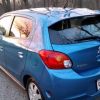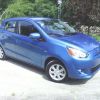For adjusting camber, we need an inclinometer to accurately measure it.
If you want to adjust camber, toe-in MUST be adjusted afterwards! First take care of camber, then toe-in!
Below is how I made a simple but accurate inclinometer, and how to measure and adjust camber with it. It shouldn't be difficult to copy this method, especially with the numerous pictures, but do read the text between the pix, otherwise it won't make much sense.
What follows gave me best results, but just in case, I need to mention everything is at your own risk.
First we make the inclinometer, which looks like this:

The length of the inclinometer needs to be 30cm (in medieval: 12 inches) Its body was made from a left over piece of metal bracket. The dimensions are uncritical, but it must be straight, not warped and must have a right angle, cut to 30cm length.
Assembly
The string is a piece of waxed dental floss. It comes from the rear through a narrow slit cut with a little hacksaw. A knot prevents it slipping through. The string begins 1cm (or 3/8 inch) from the top on the scale side. The top end has a dab of waterproof glue to keep it in place.
The bottom ends in in the air below the scale, and is tied to a little bolt. This weight pulls the string perpendicularly down during measurement, and the string acts as the dial of the scale. The string (dental floss) may be blackened with a marker pen for better visibility.
Next step is to print out the picture of the scale. After verification of the correct print size, it will be cut out and glued to the instrument in making. The bottom of this thread shows the scale as an attached image.
The centimeter-ruler copied on the side of the scale is there to help you print it in the correct size.
Observe the correct print size! Measured from the top at the point marked “origin” downwards to the bottom end of the scale, there should be 27cm or 10 ˝ inches. (The ruler in cm was added to aid printing it out in the correct size, and is not needed afterwards)
For those without a printer, measure from the top of the string to 27cm down. There, make a little mark 5mm to the right and 5mm to the left of the perpendicular line. Those marks represent one degree each. Of course it is better with a print out.
With a valid sized print in hand, cut off what is not needed. Refer to the topmost picture of the entire inclinometer!
You will want to end up with one piece to paste onto the bracket. The top marking “origin” is the exact point where the string starts. The line marked “perpendicular” obviously must be perpendicular when pasted onto the perpendicular metal bracket. A spirit level may be of help.
The bottom of the scale also has lines for -2° -1° zero° +1° +2° . The dots inbetween mark half a degree, being thirty minutes. (Remember, one degree has 60 minutes, 30 mins being a half a degree, much the same as with an hour of time)
Refer to the topmost picture of the entire inclinometer and paste the scale onto the bracket accordingly, making sure the perpendicular line points correctly perpendicular.
How to measure front camber
First park the car with the steering exactly straight ahead, on a flat and level surface, such as a good concrete floor of a garage. Remove hub caps, place the inclinometer on the inner hump of the rim, just as in the picture. The inclinometer only touches the inner hump, but does not rest on the tyres. Make a note of the reading. Measure on the other side, and also note your reading.
Note: The following pictures were made for illustration, and were taken on a non-flat and non-level surface. The scale of the particular inclinometer in the following pictures was an early model that has been improved on.
- Pic measurement -
According to the manual, camber should be somewhere between +0°05' and +/- 0°45' and the difference between the wheels should be less than 0° 30' (Note: Positive degree of camber means the top part of the wheel is furthest to the outside, negative camber when the lower part is furthest to the outside.)
Otherwise said, camber should be practically zero on both wheels, with no more than half a degree difference between wheels. Truly perfect would be both front wheels at exactly zero camber, but acceptable is anything within specs.
How to adjust front camber
If both wheels are perfect or within specs, do nothing further. If you want to correct camber because the reading is off, first pull the handbrake and take the wheel off. With the inclinometer firmly on the studs of the wheel nuts as shown in the picture below, adjust the height of jack until you get the same reading as before when the wheel was still mounted.
- Pic adjusting -
With the jack at correct height secure the car from a failing jack by placing something underneath, just in case… Both two nuts fastening the strut to the knuckle (see pointing finger on picture above) can be loosened a turn, and the strut rocked a little back and forth. There is usually about a degree's worth of movement possible here. That should let you find a better position with camber coming within specs. If not, camber bolts may be an option.
Please observe correct torque of strut und knuckle connecting nuts according to manual: 67 +-6Nm (49 +-4 ft-lb)
After making any camber adjustment, remount the wheel, let the jack down, push the car back and forth a few metres, then recheck camber as before with the wheel on.
Observe: Should anything hard ever have hit a front wheel from the side, such as in a minor parking accident, a strut could have easily become bent and have been causing excessive negative camber, although it still may be looking good.
NB: Any camber-changing adjustment will have changed toe-in ,and toe-in will be needing correction!
See Thread: Toe-in How to check and adjust
Rear camber can be measured in the same way, but since rear camber and rear toe-in results from the shape of the welded axle, no adjustments can be made.
EDIT:
An easy way to adjust camber, especially if it is too far out of specs, is to replace the upper "knuckle and strut connection nut" with a camber-bolt. The correct camber bolt has 12mm diameter and 60mm length.
The OEM knuckle and strut connection nut is specified at 67 +- 6Nm (49 +-4 ft-lb). A camber bolt differs, see manufacturers info for torque.
Note: If camber is way out of specs on one side, that strut may be slightly bent, and this is usually not clearly visible.
RE-EDIT:
Good and cheap camber gauges (inclinometers) are now available! See:
https://www.ebay.de/itm/185318179980...UAAOSw46RgeAlN



 2014 Mitsubishi Space Star (Mirage) 1.0L
2014 Mitsubishi Space Star (Mirage) 1.0L
 Reply With Quote
Reply With Quote
 "Scarlett and Marsha"
"Scarlett and Marsha"
 Speck
Speck

 2015 Test Mirage
2015 Test Mirage Swarthy
Swarthy